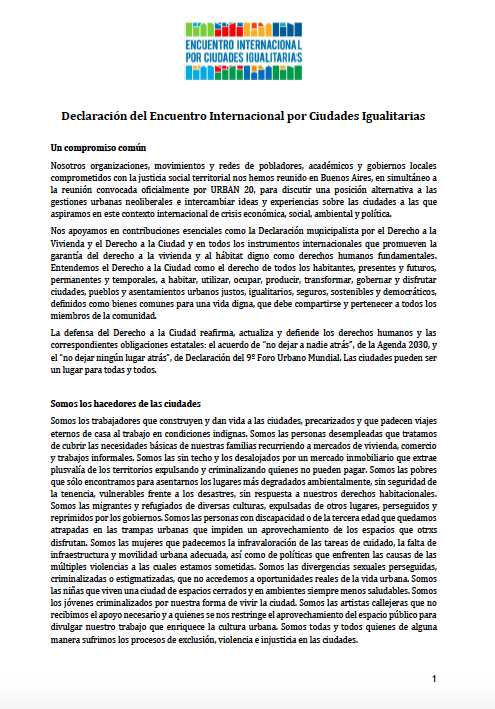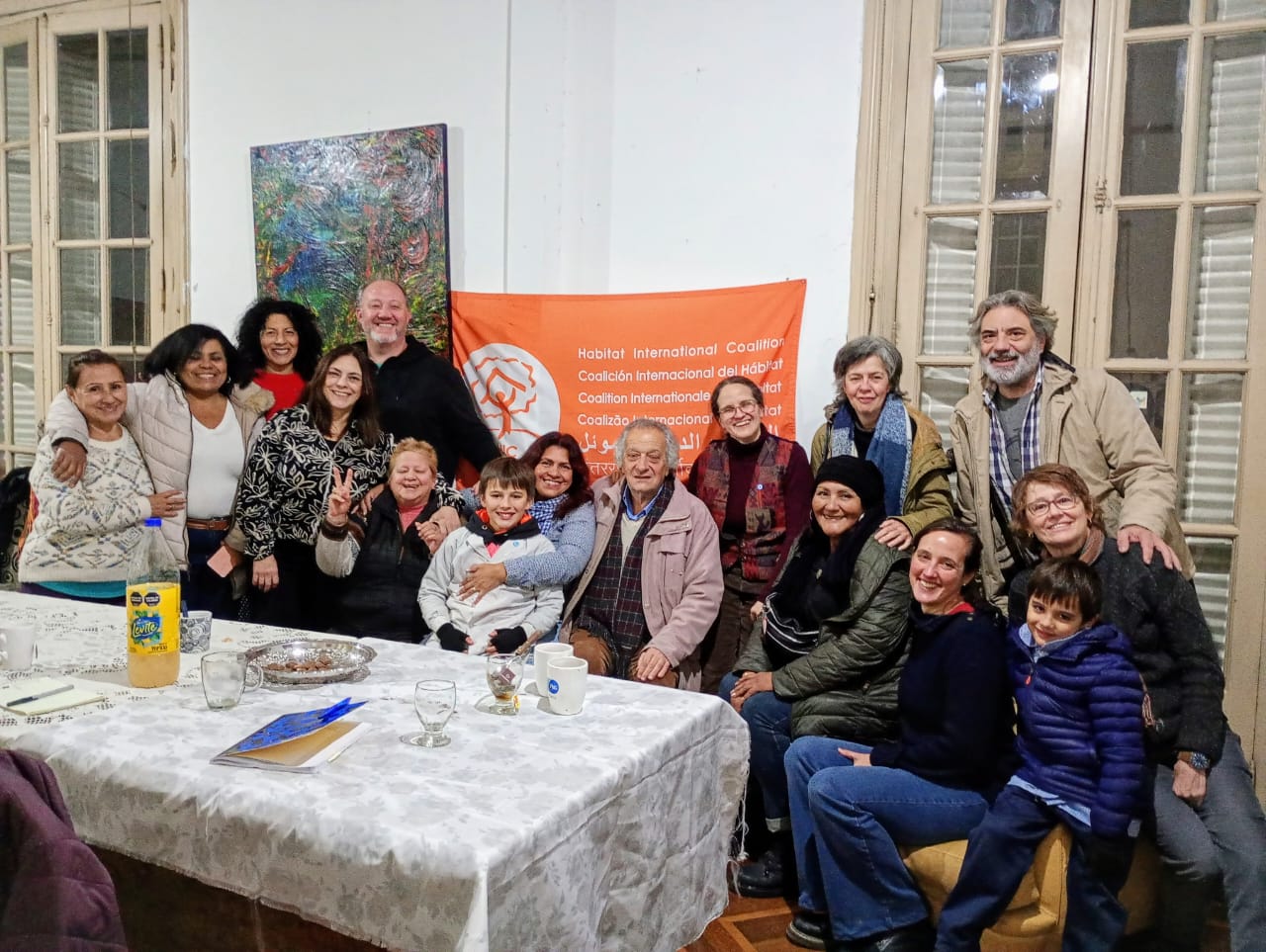The National Alliance of HUD Tenants (NAHT) welcomes the Commission’s inquiry into the status of the human right to housing in the United States, and submits these comments for your consideration and further investigation.
Founded in 1991, NAHT is the only national tenant union in the United States, representing the 1.6 million lower income families who live in privately-owned, multifamily housing developments subsidized by the Department of Housing and Urban Development (HUD), the U.S. government’s housing agency. Most of this housing was built with HUD mortgage interest subsidies and/or project-based Section 8 (tied to the buildings, not the tenants) between 1965 and 1983 and generally targeted to households earning less than 80% of the median income.
Today, NAHT’s membership includes tenant unions and areawide HUD tenant coalitions in 23 states. Since its inception, NAHT has been intimately involved in the development of HUD housing policy, both through administrative advocacy with the Department and legislative advocacy on Capitol Hill. Our goal is to empower residents to participate in decisions affecting the future of their homes and to improve and preserve at-risk HUD housing as permanently affordable for lower income people. In recent years, NAHT and its affiliates have also begun to advocate for the two million additional families assisted by HUD’s Section 8 Vouchers (where subsidies are paid to landlords but tenants have choice to seek housing in the open market) serving families paid less than 50% of the median income.
NAHT is also the North American Board representative to the Habitat International Coalition (HIC), the leading global network of more than 400 social movements, research centers and non-governmental organizations concerned with housing and land rights, with consultative status to the United Nations.
Affordable HUD housing stock declines. The stock of affordable HUD housing is under assault as never before. Since 1996, when Congress restored the ability of private owners to opt out of HUD subsidy contracts, more than 300,000 units in multifamily apartment complexes have been lost as affordable housing as owners convert to high market rents, beyond the means of the previous tenants. Moreover, the rate of conversions has increased since 1999, despite the adoption of a voluntary incentive program by Congress in that year (see NAHT’’s Report submitted before the U.S. Senate’’s Subcommittee on Housing and Transportation on October 9, 2002, available on NAHT’’s website at www.saveourhomes.org ).
While the US government has not funded a program for new affordable housing for families since 1983, the population needing such housing continues to grow. In this context, the steady erosion of about 50,000 units annually of previously-built affordable HUD-subsidized housing is a direct cause of the growth in homelessness and overcrowding among the poor, who are squeezed out of the bottom of a market they are unable to afford. Plainly, HUD’s voluntary incentive programs are inadequate to persuade owners to maintain affordable housing. Nor have Congress or HUD taken any steps to restore the regulatory framework (the Title II and Title VI Preservation Programs) which preserved these buildings as affordable housing from 1987-1996. This failure to address the on-going privatization and deregulation of existing housing, and its results in growing homelessness, mark a fundamental violation of the principal of “progressive realization” and non-regressivity recognized by Article 26 of the OAS’’ American Convention and their subsequent juridical elaboration.
In addition, HUD has systematically undermined retention of affordable housing in buildings with Section 8 and/or HUD mortgage insurance where HUD has suspended Section 8 or foreclosed due to mortgage deliquency and/or failure to maintain minimum housing standards. Although Congress has given HUD broad authority to dispose of these buildings in a manner which preserves their character as low income housing, in practice HUD has done the opposite in almost every case. Between 1994 and 2000, HUD sold off more than 26,000 units without adequate use restrictions to preserve their character as decent affordable housing.
HUD policy changes since 2002 have accelerated this trend. In New York City alone, 19,000 families currently face an uncertain future as HUD moves forward with inadequately restricted foreclosure auctions, sales to questionable speculators, and similar discretionary policies contrary to tenant and community wishes. In Newark, New Jersey, Baltimore, Maryland, and Garland, Texas, HUD has even funded unnecessary demolition of occupied housing over the strenuous protests of residents, who supported renovation instead. In Washington, D.C., HUD’s attempt to terminate Section 8 contracts in five substandard developments in early 2004–displacing and punishing the tenants for the sins of their landlords– in early 2004 drew widespread tenant protests.
Section 8 Voucher Programs. In 1996, when Congress repealed the regulatory protections of Title VI, it at least provided existing tenants with special Section 8 Vouchers which would, in theory, protect these families from displacement as owners opted out of project-based HUD subsidy contracts. These “enhanced vouchers” covered the new “market” rent paid to owners until these families moved out or passed away. Although, over time, the affordable housing stock would be lost, at least existing families would be held harmless. These vouchers are then added to the overall Section 8 voucher pool subject to annual funding by Congress.
Created by Congress in 1974, until 2003 the Section 8 Voucher Program enjoyed bi-partisan support, and was progressively expanded in most years by Congressional authorization of “incremental vouchers” added to the total previously in use, in addition to the “enhanced vouchers” resulting from owner opt-outs from HUD multifamily buildings. Although Section 8 was never declared an “entitlement” program and served (along with privately-owned HUD multifamily housing and the separate sector of “public” housing owned by local governments) less than 25% of the eligible lower income families who qualified for government assistance, at least this progressive expansion could be claimed by the US government as more or less consistent with its obligations under Article 26.
In recent years, as the Section 8 program became subject to “annual appropriation” by Congress, tenants were always assured that both parties were committed to fully funding existing Section 8 tenants. The millions of homeless and other desperate poor families on multi-year waiting lists for Section 8 assistance could at least take some comfort that in most years Congress had progressively added a few more “incremental vouchers” which might trickle down to them.
Bush Administration seeks deep cuts in Section 8 funding. However, starting in 2004, the Bush Administration has proposed deep cuts in the Section 8 Voucher Program which have shattered this bi-partisan support and needlessly put existing families at risk of losing their homes. As federal budget deficits have mounted to pay for the Administration’s programs of tax cuts for the very wealthy and the war in Iraq, pressure on Congress to cut other domestic programs has increased. In this climate, programs such as Section 8 which serve relatively powerless constituences such as low income tenants are particularly vulnerable.
In its FY 2004 and 2005 budget requests, the Administration requested from Congress less money than was required to guarantee renewal of existing vouchers in place–the first time in the 30 year history of Section 8 that an Administration had proposed this. In FY 2004, following vigorous protests by NAHT and others, Congress restored $900 million to the Administration’s request, averting a potential elimination of funding for 185,000 families. In FY 2005, the Administration tried again, proposing to drop 250,000 families from Section 8 in 2005 and 600,000 by 2009–a 30% reduction in the number of families served; again, Congress restored $1.4 billion to the Administration’s request, with the aim of fully funding existing families in place.
These attempts to roll back Section 8 assistance have already been criticized by global housing rights agencies. Attached is an Open Letter to President Bush sent by the Habitat International Coalition/ Housing and Land Rights Network on October 4, 2004, addressing these concerns in relation to the International Covenant on Civil and Political Rights (ICCPR), to which the US is a party, among other violations of housing rights norms.
Cutting the program “through the back door.” Having failed to win Congressional support for its effort to cut the program, the Administration has launched a campaign to cut it “through the back door,” by administrative measures. In spring 2004, HUD suddenly cut reimbursements to Housing Authorities retroactively, forcing these agencies to lower payments to landlords or throw tenants out on the street. Agencies which had done a good job getting vouchers out to desperate homeless and other families on waiting lists were singled out for punishment for temporarily tapping into reserve accounts while balancing program accounts at the end of the year (HUD and Congress had previously encouraged this practice to ensure that the intended number of vouchers made it into the hands of needy recipients). By suddenly reversing the rules of the game, HUD caught many agencies short, forcing them to take extreme administrative measures, including termination of subsidies to existing families in place. Since Section 8 typically pays 2/3 of a family’s rent (tenants pay 30% of their household income for rent, and HUD pays the difference to a pre-determined contract rent to landlords), subsidy termination means an overnight tripling of rents to very low income people and almost certain displacement.
HUD took other steps to make the Section 8 program unworkable. In September 2004, HUD published new Fair Market Rents, which set the value of Section 8 vouchers in areawide markets throughout the country. In many cities, HUD inexplicably cut payments to landlords for large bedroom families, which serve large low income families. In Boston, for example, Section 8 Vouchers rents were cut by $153 per month for a two bedroom apartment (from $1,419 to $1,266 per month), and by $262 per month (to $1,513) for three bedrooms and $408 per month (to $1,676) for four bedroom apartments in Greater Boston. These cuts will either force landlords to take a cut in rent, and/or tenants to move to a less expensive apartment or pay the difference up to the old rent. Thousands of families could lose their homes as landlords drop out of the program.
Families aided with Section 8 Vouchers decline. The 2,500 Housing Authorities which administered Section 8 across the country were thrown into chaos as a result of this unnecessary crisis. At its height, the National Association of Housing and Redevelopment Officials (NAHRO) estimated that 60,000 US families faced subsidy termination–in effect, the forced eviction of low income families across the country. Vigorous protests by NAHT, the National Coalition for the Homeless, disability rights groups and local housing authorities and elected officials forced HUD to relent to some extent, and funds were restored to most agencies. Nevertheless, the Administration’s plans to cut the program were advanced: local agencies have ended temporary “overleasing,” frozen waiting lists, and taken other measures which cumulatively resulted in 4% fewer vouchers in use by the end of 2004. Since Congress funds the number of vouchers in use for the following year, the Administration may yet achieve its planned phase-out of 30% of the program by these punitive administrative means.
Following adoption of the FY 2005 budget, which Congress intended to fund at a level sufficient to fund the (reduced) number of vouchers in use, HUD announced a further cut of 4% based on the fact that information it had provided Congress in its deliberations the previous year was inaccurate and “mistaken.”. As a result, in January 2005 HUD informed local agencies of funding allocations which will mean an additional cut of 80,000 families from Section 8 by the end of the year. This cutback has reinforced local agencies’ hesitation to fully lease up available vouchers as they become available, to harden the freeze on waiting lists, and to take other cautious measures to avoid being caught short again. Since this will further reduce the number of vouchers in use by the end of the fiscal year, Congress’ full funding of vouchers in use for the following year will reflect further reductions, and so on. By this means, the Administration may be able to achieve its announced goal of a 30% cut by 2009–explicitly rejected by Congress last year–through administrative means.
Although the Administration at first glance appears to have requested an additional $1 billion in its FY 2006 request for Section 8, this does not signify a change of heart to support the program. First, most of the increase is explained by new “enhanced vouchers” provided last year to tenants from project-based Section 8 housing where owners opted out or for public housing demolitions or similar unavoidable program cost increases. Second, the FY 2006 request, if funded, will only partially offset the 4% effective cut (not intended by Congress) in FY 2005. Third, the budget request proposes a “hard cap” on future program costs which will result in the elimination of 375,000 vouchers by 2010. The Administration has also proposed to shift the funding formula for the Section 8 program to a “dollar based” system, and plans to again file legislation to “block grant” Section 8 Vouchers to local agencies. These changes, if adopted, will inevitably result in long-term funding reductions which have invariably accompanied block grant programs in the past. In addition, the Administration has proposed deep cuts ($2 billion, or 35%) to HUD’s popular Community Development Block Grant program and its transfer to another agency; as Congress considers HUD’s budget, pressure to fully fund this program by cutting other areas of the HUD budget, such as Section 8, will be hard to resist.
HUD strategy to undermine support for Section 8. It is important to note that the Section 8 program until last year was generally operating at a high level of efficiency and public support. Congressionally-mandated administrative changes in recent years had improved overall program accounting, phased out hidden reserves, and were working to make sure that the maximum number of recipients were served each year. HUD’s radical administrative changes were so comprehensive and systematic that they cannot be explained merely by incompetence, but should be seen as a calculated strategy to undermine support for a successful program. Like the Administration’s contrived assault on Social Security, we believe that Section 8 was singled out precisely because it is a successful program of social support to the poor. We request that the Commission investigate this issue of political strategy and intention and weigh it in determining whether the US is in violation of Article 26.
Should the Administration’s Block Grant proposal be accepted, HUD has indicated that Housing Authorities should manage reduced funding levels by imposing program cutbacks on tenants, such as time limits on Section 8 assistance, higher rents, and targeting benefits to higher income eligible families to allow limited funds to serve more families. Significantly, HUD’s Voucher Block Grant proposal was dubbed Housing Assistance to Needy Families (HANF), similar to the time-limited assistance program for welfare recipients (TANF). Although Congress has so far not taken action on this proposal, HUD is pushing local agencies to adopt these measures administratively, for example through its effective control of the Los Angeles agency.
Worse, the Administration is now trying to paint Section 8 tenants as “criminals” responsible for the federal budget deficit. In Dallas, 900 families were sent eviction letters for alleged offenses before they became tenants, some as long as 20 years ago. (Local protests successfully stopped this effort.)
In spring 2004, HUD began to stage raids by teams of federal agents to arrest tenants for alleged underpayment of rent in Section 8 units. In several California cities, Federal agents arrived unannounced at tenants’ homes at 6:00 AM, with no notice or warrant, to look for ‘violations’ of HUD occupancy requirements, make arrests, and even remove children from their families. Newspaper reports have documented similar arrests of tenants alleged underpayment of rent in several states. HUD has falsely claimed that Section 8 Voucher tenants are underpaying $1.2 billion in rents (this figure adds estimated overpayments by tenants to alleged “underpayments”). Taken together, the Administration seems to be laying the groundwork for a press campaign through its allies in the right wing media designed to erode public support for the program.
“Starving the beast”. Behind the Administration’s attempts to undermine Section 8 is a strategy dubbed “starving the beast” by some of the Administration’s favorite intellectuals, such as Grover Norquist of Americans for Tax Reform and Howard Husock of the right wing think tank the Manhattan Institute. In this vision, the Administration has created huge budget deficits by pushing through massive tax cuts for the wealthy coupled with huge budget increases for war and “homeland security.” This creates long-term, structural pressures to close the growing deficit by slashing non-military domestic programs, such as housing, health care, education and social security. As the quality of these services and the agencies that run them declines, public support weakens, making deeper cuts and even agency abolition politically feasible in the future.
Accordingly, there is some urgency to the Commission’s investigation of the US government’s failure to meet its obligations under the OAS human rights regime. The Bush Administration is systematically pursuing administrative measures and legislative proposals which reduce the affordable housing stock and the number of needy families served with Section 8 Vouchers, while opposing new affordable housing production programs to meet rising needs. Far from “progressive realization” of housing rights for the nation’s families, the Administration is intentionally pursuing the opposite.
We applaud the Commision’s efforts and will be happy to cooperate in any way with your investigation should it proceed.
Sincerely,
Executive Secretary
Inter-American Commission on Human Rights
Organization of American States
1889 F Street NW
Washington, D.C. 20006




